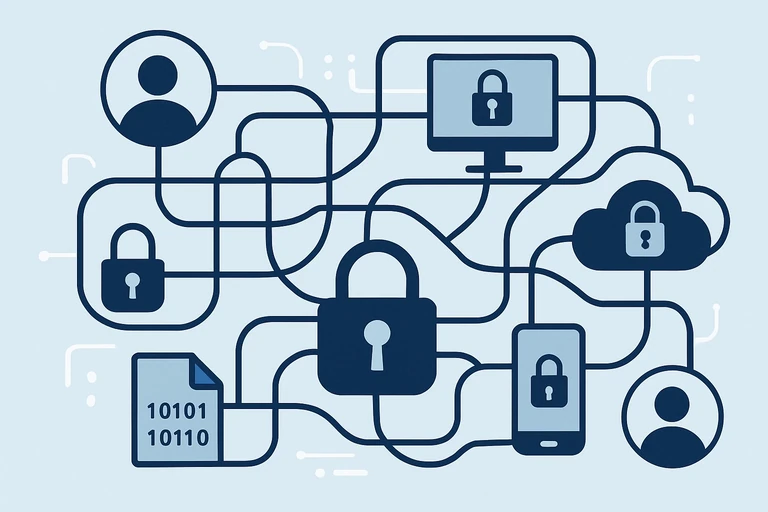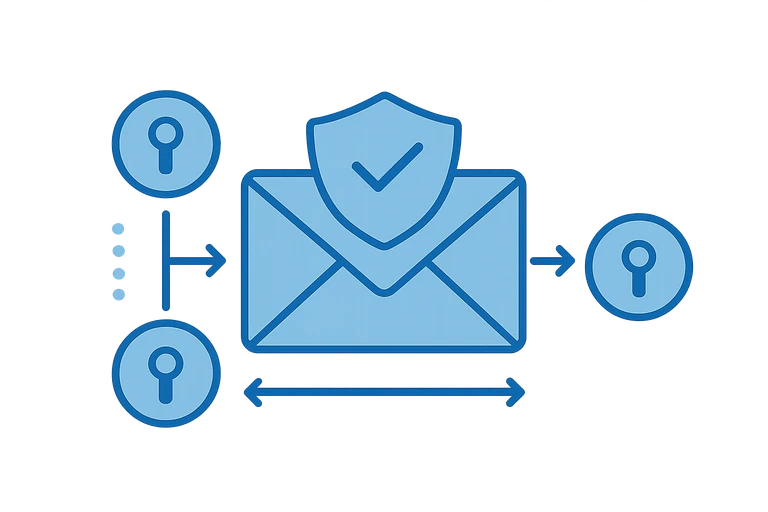The Rise of Autonomous Agents in 2025 explores practical patterns, platforms, and governance conside...

Zero Trust: the New Standard of Corporate Security
Zero Trust is redefining corporate security as the standard approach for protecting people, data, and workloads in hybrid and multi-cloud environments. This post explains the core principles, building blocks, and a practical six-phase roadmap to implement Zero Trust with real-world impact.
Introduction
In today’s digital landscape, perimeter-based security is no longer sufficient. The escalating use of cloud services, remote work, and multi-cloud infrastructures means attackers can exploit countless entry points, from compromised credentials to vulnerable devices. Zero Trust offers a pragmatic, risk-based approach to security: never trust by default, always verify, and continuously validate every access attempt. What began as a theoretical model has matured into a practical framework embraced by organizations of all sizes as the new standard for securing people, data, and applications. This post explains what Zero Trust is, why it matters, and how to implement it in a way that delivers measurable business value.
What is Zero Trust?
Zero Trust is a security strategy—not a single product—that requires strict identity verification for every person and device attempting to access resources, regardless of where the request originates. It emphasizes continuous authentication, authorization, and encryption, with access granted only to the minimum required resources. This approach aligns with modern realities: employees work from diverse locations, on various devices, and with cloud-based workloads. See how major vendors frame the model to emphasize explicit verification, least-privilege access, and an assumed-breach mindset.
Key sources describe Zero Trust as an end-to-end security philosophy that extends beyond the corporate network to identities, endpoints, data, apps, and infrastructure. It’s designed to be integrated across an organization and adaptable to different technology footprints and stages of maturity.
Foundational references: Zero Trust is described as a strategy that must verify every access request and adapt to modern, mobile, cloud-enabled enterprises.
Core Principles of Zero Trust
Three core principles anchor any Zero Trust program, regardless of industry or scale:
- Verify explicitly: Authenticate and authorize using all available data points (identity, device health, location, data sensitivity, workload, user behavior, and real-time risk signals). This principle is central to many vendor frameworks and is emphasized by leading security providers.
- Limit access with least privilege: Apply just-in-time (JIT) and just-enough-access (JEA) policies, with adaptive risk-based controls. This reduces blast radius and prevents lateral movement if a credential or device is compromised.
- Assume breach: Operate under the assumption that the network is compromised. Encrypt end-to-end, segment resources, and continuously monitor to detect anomalous activity.
These principles are echoed in rigorous standard bodies and leading vendor documentation, including the NIST Zero Trust Architecture framework.
Key Building Blocks of a Zero Trust Architecture (ZTA)
A practical ZTA consists of interlocking components that work together to enforce policy, visibility, and response. Here are the core building blocks you’ll typically implement in stages:
- Identity and access management (IAM): Strong authentication (preferably multi-factor authentication), federated identity, and granular access controls that tie permissions to the user’s role, device posture, and the data being accessed.
- Device posture and endpoint security: Continuous assessment of device health, patch status, and compliant configurations before granting access to sensitive resources.
- Micro-segmentation and network access control: Fine-grained segmentation that restricts lateral movement at the resource level rather than relying on a perimeter boundary. ZT Network Access (ZTNA) solutions are a common replacement for traditional VPNs in Zero Trust environments.
- Data security and data-centric protection: Classification, encryption, DLP controls, and policy-driven access to data based on sensitivity and context.
- Application security and workload protection: Positive security models, runtime protection, and continuous risk assessment of workloads, apps, and services.
- Analytics, visibility, and threat intelligence: Centralized policy orchestration, real-time telemetry, and behavior analytics to detect anomalous access patterns and accelerate response.
- Policy engine and enforcement: A single policy layer that interprets signals from identities, devices, networks, data, apps, and workloads, and enforces least-privilege access dynamically.
For a credible reference point, the official Zero Trust definitions from Microsoft, along with NIST’s guidance, emphasize this holistic, signal-driven enforcement approach across the entire digital estate.
Why Zero Trust Matters Now
The modern enterprise operates in a hybrid, cloud-first world where traditional perimeters are porous or effectively invisible. The benefits of adopting Zero Trust include:
- Better protection against credential theft and insider threats by not trusting anyone by default.
- Reduced blast radius through micro-segmentation and just-in-time access.
- Improved risk visibility and faster detection and response using continuous analytics and policy enforcement.
- Support for multi-cloud and remote work scenarios with consistent security controls across environments.
These principles are not merely theoretical. Leading security research and practitioner guidance show that Zero Trust maturity correlates with lower breach costs and more resilient security postures, especially when paired with automation and AI-enabled security operations. IBM’s analyses highlight that mature Zero Trust approaches are associated with lower breach costs and faster containment.
How to Implement Zero Trust: A Practical 6-Phase Roadmap
Adopting Zero Trust is a journey, not a one-time project. Use a phased approach that aligns with business priorities, risk, and technology debt. Below is a pragmatic six-phase plan you can tailor to your organization.
- Phase 0 — Define what you protect: Create an inventory of data, apps, and services that are most sensitive or critical to operations. Map owners, data classifications, and access requirements. Establish a measurable security baseline and governance structure.
- Phase 1 — Identity-first foundation: Implement strong authentication (prefer MFA), standardize identity across cloud and on-prem systems, and adopt an IAM model that supports least privilege. Introduce Just-In-Time access for privileged roles (PAM where appropriate) and start with high-risk assets.
- Phase 2 — Device and endpoint posture: Enforce device compliance checks, patch status, and security baselines before granting access. Integrate endpoint protection platforms (EPP/EDR) and ensure secure configuration management.
- Phase 3 — Network segmentation and secure access: Move from flat networks to micro-segments and adopt ZTNA for application access. Establish policy-based access controls that depend on identity, device health, user behavior, and data sensitivity.
- Phase 4 — Data protection everywhere: Enforce data-centric security: classification, encryption at rest and in transit, data loss prevention (DLP) policies, and controlled data sharing with fine-grained permissions.
- Phase 5 — Continuous monitoring and response: Build a security operations capability that continuously analyzes telemetry from identities, devices, networks, and apps. Implement anomaly detection, automated playbooks, and threat hunting to shorten MTTR.
- Phase 6 — Governance, risk, and culture: Establish policies, training, and audits. Align with compliance frameworks, embed security into development (DevSecOps), and measure progress with maturity indicators and business outcomes.
Tip: Start with a critical path of assets that would cause the greatest business impact if exposed, such as personal data, financial systems, and core customer platforms. Expand gradually to less sensitive assets as your policy engine and telemetry improve.
Real-World Scenarios: How Zero Trust Reduces Risk
Consider these practical scenarios to illustrate Zero Trust in action:
- Remote workforce: A distributed workforce accesses SaaS and cloud-hosted apps. With ZTNA, each access request is authenticated, device posture is evaluated, and access to sensitive data is restricted to the minimum necessary scope. This reduces exposure even if a user’s device is compromised.
- Cloud migration: An organization moving workloads to a multi-cloud environment uses consistent identity-based policies, micro-segmentation, and encryption to prevent lateral movement across clouds.
- Third-party risk: Vendor access is limited with time-bound, need-to-know access and continuous monitoring of activity, reducing risk from external partners.
These scenarios reflect a broader industry trend toward Zero Trust as the standard approach to securing multi-cloud, remote, and complex infrastructures. For reference, major vendors describe Zero Trust as a holistic, identity-centric security model designed to minimize risk across all domains.
ROI and Confidence: What to Expect from a Zero Trust Program
Quantifying the return on a Zero Trust program depends on scope and maturity, but several independent analyses point to tangible financial and operational benefits. Notably, studies from IBM/X-Force indicate that mature Zero Trust deployments, paired with security automation, correlate with lower breach costs and faster containment. While costs vary by industry and organization, the trend is clear: Zero Trust not only improves security posture but can meaningfully reduce the financial impact of incidents.
Beyond the numbers, Zero Trust reduces the risk of costly breaches, accelerates response times, and supports more agile business operations in the cloud era. As organizations adopt AI-assisted security and automation, the efficiency of detection, investigation, and containment improves, further enhancing overall resilience.
Common Challenges and How to Overcome Them
Implementing Zero Trust is transformative but not without hurdles. Here are frequent challenges and practical mitigations:
- Complexity and migration risk: Start with a prioritized, data-driven plan and deliver measurable wins in 90–120 day cycles. Use phased rollouts and policy as code to reduce friction.
- User experience concerns: Invest in Single Sign-On (SSO), frictionless MFA methods, and adaptive access controls that minimize impact on productivity while strengthening security.
- Tooling and integration: Build a platform- and vendor-agnostic policy layer that can weave together IAM, EDR, ZTNA, DLP, and cloud security tools. Consider a pathway toward SASE for consistent security at the edge.
- Data classification and governance: Implement data classification frameworks early, so you can apply context-aware access and encryption where it matters most.
These approaches align with the broader reality that Zero Trust is about coordinated people, processes, and technology—each reinforcing the others to deliver resilient security outcomes.
The Future of Zero Trust: AI, Automation, and Beyond
The Zero Trust paradigm continues to evolve as organizations adopt AI-assisted security operations, improve telemetry, and integrate more tightly with software supply chains. Expect to see:
- Advanced analytics and risk scoring: Continuous risk assessment that dynamically adapts policies as contexts change (e.g., user behavior shifts, device posture changes, or data sensitivity updates).
- Automation-driven playbooks: Security orchestration, automation, and response (SOAR) capabilities that reduce MTTR and free human analysts for higher-value work.
- Deeper integration with DevSecOps: Shifting security left in the development lifecycle, with automatic policy generation from code and pipeline telemetry.
- Edge and IoT considerations: Extending Zero Trust controls to edge devices and IoT environments with scalable identity, device posture, and data protection.)
Industry guidance continues to emphasize that Zero Trust should be a continuously evolving strategy—one that adapts to new threats, new work patterns, and new architectural realities. The official NIST guidance confirms that Zero Trust is a flexible framework designed to help organizations deploy targeted protections across diverse environments.
Why Multek? How We Help You Achieve Zero Trust
Multek specializes in building high-performance software and intelligent security architectures that are pragmatic, measurable, and aligned with business goals. We help you:
- Assess current maturity and map a data-driven Zero Trust roadmap aligned with your risk appetite.
- Design identity-centric access controls, integrate with your IAM/SAML/OIDC providers, and implement adaptive, least-privilege policies.
- Implement micro-segmentation, ZTNA for remote access, and data-centric security controls across cloud and on-prem environments.
- Establish continuous monitoring, analytics, and automated response workflows to shorten breach detection and containment times.
While the content above provides a blueprint, your organization will benefit from a tailored, phased plan—and a partner who can translate security strategy into business outcomes. If Zero Trust is on your agenda, we can help you design a pragmatic path that fits your stack and your budget.
Conclusion
Zero Trust represents a disciplined, evidence-based approach to security for a world where trust by default is no longer acceptable. By verifying explicitly, enforcing least privilege, and assuming breach, organizations can reduce risk, improve compliance readiness, and enable safer digital transformation across on-premises, cloud, and edge environments. The journey requires a clear data view, strong identity and device posture, network-aware segmentation, and robust monitoring—delivered through a converged policy framework and automation. As you embark on this journey, remember that Zero Trust is not a one-off project; it’s a continuous, adaptive security posture that grows with your business.


